Eco-Friendly Alternative Disposal through the Pyrolysis Process of Meat and Bone Meal
Abstract
1. Introduction
2. Materials and Methods
2.1. MBM Preparation
2.2. Catalysts Preparation
2.3. Characterization Methods
2.4. Pyrolysis Process
3. Results and Discussions
3.1. MBM Toxicity
3.2. SBA-16 Support and Catalysts’ Characterization
3.3. SBA-3 Support and Catalysts Characterization
3.4. MBMPYOIL Characteristics
3.5. MBMPYGAS Characteristics
3.6. MBMPYCHAR and Selective Adsorbent Materials
4. Conclusions
Author Contributions
Funding
Institutional Review Board Statement
Informed Consent Statement
Data Availability Statement
Acknowledgments
Conflicts of Interest
References
- Cheela, V.; John, M.; Biswas, W.; Dubey, B. Environmental Impact Evaluation of Current Municipal Solid Waste Treatments in India Using Life Cycle Assessment. Energies 2021, 14, 3133. [Google Scholar] [CrossRef]
- Wang, K.; Nakakubo, T. Comparative assessment of waste disposal systems and technologies with regard to greenhouse gas emissions: A case study of municipal solid waste treatment options in China. J. Clean. Prod. 2020, 260, 120827. [Google Scholar] [CrossRef]
- Gholizadeh, M.; Li, C.; Zhang, S.; Wang, Y.; Niu, S.; Li, Y.; Hu, X. Progress of the development of reactors for pyrolysis of municipal waste. Sustain. Energy Fuels 2020, 4, 5885–5915. [Google Scholar] [CrossRef]
- Ariyaratne, W.K.W.K.H.; Malagalage, A.; Melaaen, M.C.; Tokheim, L.A. CFD Modeling of Meat and Bone Meal Combustion in a Rotary Cement Kiln. Int. J. Model. Optim. 2014, 4, 263–272. [Google Scholar] [CrossRef]
- Islam, N.; Siddiqui, S.I.; Islam, T.; Islam, R.; Chowdhury, E.H. Usage of meat and bone meal in animal, poultry and fish feeds: A survey and risk analysis for the occurrence of bovine spongiform encephalopathy in Bangladesh. Veter.-Med. Sci. 2021, 8, 377–386. [Google Scholar] [CrossRef] [PubMed]
- Woodgate, S.L.; Wilkinson, R.G. The role of rendering in relation to the bovine spongiform encephalopathy epidemic, the development of EU animal by-product legislation and the reintroduction of rendered products into animal feeds. Ann. Appl. Biol. 2021, 178, 430–441. [Google Scholar] [CrossRef]
- Colgan, S.; O’Brien, L.; Maher, M.; Shilton, N.; McDonnell, K.; Ward, S. Development of a DNA-based assay for species identification in meat and bone meal. Food Res. Int. 2001, 34, 409–414. [Google Scholar] [CrossRef]
- Conesa, J.A.; Fullana, A.; Font, R. Dioxin production during the thermal treatment of meat and bone meal residues. Chemosphere 2005, 59, 85–90. [Google Scholar] [CrossRef]
- Yamamoto, T.; Kato, M.; Endo, K.; Kotoura, S.; Takeda, Z. Detection of ruminant meat and bone meal in feeds by sandwich ELISA with monoclonal antibodies. J. Veter.-Med. Sci. 2015, 77, 1605–1609. [Google Scholar] [CrossRef][Green Version]
- Hicks, T.M.; Verbeek, C.J.R. Chapter 3-Meat Industry Protein By-Products: Sources and Characteristics. In Protein Byproducts; Transformation from Environmental Burden Into Value-Added Products; Academic Press: Cambridge, MA, USA, 2016; pp. 37–61. [Google Scholar]
- Boumanchar, I.; Chhiti, Y.; Ezzahrae M’hamdi Alaoui, F.; Elkhouakhi, M.; Sahibed-dine, A.; Bentiss, F.; Jama, C.; Bensitel, M. Investigation of (co)-combustion kinetics of biomass, coal and municipal solid wastes. Waste Manag. 2019, 97, 10–18. [Google Scholar] [CrossRef]
- Bilandzija, N.; Voca, N.; Jelcic, B.; Jurisic, V.; Matin, A.; Grubor, M.; Kricka, T. Evaluation of Croatian agricultural solid biomass energy potential. Renew. Sustain. Energy Rev. 2018, 93, 225–230. [Google Scholar] [CrossRef]
- Wang, S.; Pavuluri, C.M.; Ren, L.; Fu, P.; Zhang, Y.-L.; Liu, C.-Q. Implications for biomass/coal combustion emissions and secondary formation of carbonaceous aerosols in North China. RSC Adv. 2018, 8, 38108–38117. [Google Scholar] [CrossRef]
- Kazagic, A.; Hodzic, N.; Metovic, S. Co-Combustion of Low-Rank Coal with Woody Biomass and Miscanthus: An Experimental Study. Energies 2018, 11, 601. [Google Scholar] [CrossRef]
- Jayathilakan, K.; Sultana, K.; Radhakrishna, K.; Bawa, A.S. Utilization of by products and waste materials from meat, poultry and fish processing industries: A review. J. Food Sci. Technol. 2012, 49, 278–293. [Google Scholar] [CrossRef]
- Lee, J.; Kim, S.Y.; Hwang, K.J.; Ju, Y.R.; Woo, H.-J. Prion Diseases as Transmissible Zoonotic Diseases. Osong. Public Heal. Res. Perspect. 2013, 4, 57–66. [Google Scholar] [CrossRef]
- Holttinen, J. Utilization of Meat and Bone Meal for Energy Production. Master’s Thesis, Lappeenranta University of Technology Finland, Lappeenranta, Finland, 2011. Available online: https://citeseerx.ist.psu.edu/viewdoc/download?doi=10.1.1.886.2196&rep=rep1&type=pdf (accessed on 25 August 2022).
- Kwant, K.W. Renewable energy in The Netherlands: Policy and instruments. Biomass-Bioenergy 2003, 24, 265–267. [Google Scholar] [CrossRef]
- Cascarosa, E.; Boldrin, A.; Astrup, T. Pyrolysis and gasification of meat-and-bone-meal: Energy balance and GHG accounting. Waste Manag. 2013, 33, 2501–2508. [Google Scholar] [CrossRef]
- Cascarosa, E.; Gea, G.; Arauzo, J. Thermochemical processing of meat and bone meal: A review. Renew. Sustain. Energy Rev. 2012, 16, 942–957. [Google Scholar] [CrossRef]
- Deydier, E.; Guilet, R.; Sarda, S.; Sharrock, P. Physical and chemical characterization of crude meat and bone meal combustion residue: “waste or raw material?”. J. Hazard. Mater. 2005, 121, 141–148. [Google Scholar] [CrossRef]
- Fryda, L.; Panopoulos, K.; Vourliotis, P.; Kakaras, E.; Pavlidou, E. Meat and bone meal as secondary fuel in fluidized bed combustion. Proc. Combust. Inst. 2007, 31, 2829–2837. [Google Scholar] [CrossRef]
- Vamvuka, D.; Papas, M.; Alloimonos, N.; Kapenekaki, M. Evaluation of meat and bone meal as a secondary fuel with olive by products in a fluidized bed unit. Energy Fuels 2017, 31, 7214–7222. [Google Scholar] [CrossRef]
- Ariyaratne, W.; Melaaen, M.; Eine, K.; Tokheim, L. Meat and bone meal as a renewable energy source in cement kilns: Investigation of optimum feeding rate. Renew. Energy Power Qual. J. 2011, 1, 1244–1249. [Google Scholar] [CrossRef]
- Ariyaratne, W.K.H.; Manjula, E.V.P.J.; Melaaen, M.C.; Tokheim, L.A. Kiln Process Impact of Alternative Solid Fuel Combustion in the Cement Kiln Main Burner–Mathematical Modelling and Full-Scale Experiment. Adv. Mater. Res. 2014, 875–877, 1291–1299. [Google Scholar] [CrossRef]
- Ariyaratne, W.K.H.; Melaaen, M.C.; Tokheim, L.-A. CFD Modeling of Multi-fuel Combustion of Coal and Meat and Bone Meal (MBM) in a Cement Rotary Kiln. Int. J. Model. Optim. 2015, 5, 353–360. [Google Scholar] [CrossRef]
- Gulyurtlu, I.; Boavida, D.; Abelha, P.; Lopes, M.; Cabrita, I. Co-combustion of coal and meat and bone meal. Fuel 2005, 84, 2137–2148. [Google Scholar] [CrossRef]
- McDonnell, K.; Cummins, E.J.; Fagan, C.C.; Orjala, M. Co-Fuelling of Peat with Meat and Bone Meal in a Pilot Scale Bubbling Bed Reactor. Energies 2010, 3, 1369–1382. [Google Scholar] [CrossRef]
- Farobie, O.; Amrullah, A.; Bayu, A.; Syaftika, N.; Anis, L.A.; Hartulistiyoso, E. In-depth study of bio-oil and biochar production from macroalgae Sargassum sp. via slow pyrolysis. RSC Adv. 2022, 12, 9567. [Google Scholar] [CrossRef]
- Amrullah, A.; Farobie, O.; Septarini, S.; Satrio, J.A. Synergetic biofuel production from co-pyrolysis of food and plastic waste: Reaction kinetics and product behaviour. Heliyon 2022, 8, e10278. [Google Scholar] [CrossRef]
- Albouy, P.-A.; Ayral, A. Coupling X-ray Scattering and Nitrogen Adsorption: An Interesting Approach for the Characterization of Ordered Mesoporous Materials. Application to Hexagonal Silica. Chem. Mater. 2002, 14, 3391–3397. [Google Scholar] [CrossRef]
- Sakamoto, Y.; Kaneda, M.; Terasaki, O.; Zhao, D.; Kim, J.M.; Stucky, G.; Shin, H.J.; Ryoo, R. Direct imaging of the pores and cages of three-dimensional mesoporous materials. Nature 2000, 408, 449–453. [Google Scholar] [CrossRef]
- Ionete, R.E.; Ionete, E.I.; Spiridon, S.I.; Constantinescu, M. Solar Dryer with Humidity Extractor Used for Organic Matter, Has Installation Components that Are Arranged in Certain Succession and Configuration to Form Closed Enclosure and Allow Human Operator to Accelerate Humidity Extraction RO132880-A0, Derwent Primary Accession Number 2019-373457; 2019. Available online: https://www.webofscience.com/wos/diidw/full-record/DIIDW:2019373457 (accessed on 30 August 2022).
- Constantinescu, M.; Bucura, F.; Ionete, R.E.; Zaharioiu, A.; Ciucure, C.; Oancea, O. Sewage sludge eliminating by capitalizing on its energy potential. In Proceedings of the 17th International Multidisciplinary Scientific GeoConference SGEM, Vienna, Austria, 25–27 November 2017; Volume 43, pp. 767–774. [Google Scholar]
- Niculescu, V.C.; Constantinescu, M.; Bucura, F.; Ion-Ebrasu, D.; Soare, A. SBA-16 mesoporous nanosilica: Synthesis, characterization and sorption properties. Smart Energy Sustain. Environ. 2020, 23, 69–80. [Google Scholar] [CrossRef]
- Niculescu, V.-C.; Miricioiu, M.; Soare, A.; Marinoiu, A.; Ion-Ebrasu, D.; Constantinescu, M.; Bucura, F. SBA-3-based Nanocatalysts Application in Nile Blue Removal from Wastewater. In Proceedings of the 1st International Electronic Conference on Catalysis Sciences -ECCS2020, Online, 10–30 November 2020. [Google Scholar] [CrossRef]
- Marinoiu, A.; Jianu, C.; Cobzaru, C.; Raceanu, M.; Capris, C.; Soare, A.; Petreanu, I.; Carcadea, E. Facile synthesis of well dispersed au nanoparticles on reduced graphene oxide. Prog. Cryog. Isot. 2017, 20, 5–14. [Google Scholar]
- Constantinescu, M.; Bucura, F.; Ionete, R.-E.; Niculescu, V.-C.; Ionete, E.I.; Zaharioiu, A.; Oancea, S.; Miricioiu, M.G. Comparative Study on Plastic Materials as a New Source of Energy. Mater. Plast. 2019, 56, 41–46. [Google Scholar] [CrossRef]
- ASTM D1946-90; Standard Practice for Analysis of Reformed Gas by Gas Chromatography. ASTM: West Conshohocken, PA, USA, 2019.
- SR EN ISO 6975/C91:2015; Natural Gas. Extended Analysis. Gas Chromatographic Method. ISO: Geneva, Switzerland, 2005.
- ISO 6976; Natural Gas-Calculation of Calorific Values, Density, Relative Density and Wobbe Indices from Composition. ISO: Geneva, Switzerland, 2016.
- EN ISO 18125/may 2017; Solid Biofuels. Determination of Caloric Power. ISO: Geneva, Switzerland, 2017.
- ASTM D 240-19; Determination of the Higher Calorific Value by the Calorimeter Bomb Method and Calculation of the Lower Calorific Value for Fuel Oil, Diesel, Light Liquid Fuel and Gasoline. ASTM: West Conshohocken, PA, USA, 2019.
- Ionete, R.E.; Ionete, E.I.; Spiridon, Ş.I.; Constantinescu, M.; Bucura, F.; Miricioiu, M.G. System Used for Recycling Plastic Waste from Urban Waste Collections, Comprises Reactor Comprising Gauze Plates, Catalytic Sections, Segment for Collecting and Extracting Final Reaction Products and Container for Collecting Residue. RO133259-B1, Derwent Primary Accession Number: 2019-503685; 2019. Available online: https://www.webofscience.com/wos/diidw/full-record/DIIDW:2019503685 (accessed on 30 August 2022).
- Safe, S.H. Hazard and Risk Assessment of Chemical Mixtures Using the Toxic Equivalency Factor Approach. Environ. Health Perspect. 1998, 106, 1051–1058. [Google Scholar]
- EPA-Method 8280B; Polychlorinated Dibenzo-p-Dioxins (PCDDs) and Polychlorinated Dibenzofurans (PCDFS) by High-Resolution Gas Chromatography/Low-Resolution Mass Spectrometry (HRGC/LRMS). EPA: Washington, DC, USA, 2007.
- Vremera, R.; Costinel, D.; Ionete, R.E.; Titescu, G. Overview on Dioxins and Furans Atmospheric Emissions in Romania. Environ. Eng. Manag. J. 2011, 10, 241–250. [Google Scholar] [CrossRef]
- Zaharioiu, A.; Bucura, F.; Constantinescu, M.; Petreanu, I.; Marin, F.; Popescu, D.I.; Sandru, C.; Ionete, E.I.; Oancea, S.; Ionete, R.E. An Alternative for Valorization of Wastes as Energy Source. SMART Energy Sustain. Environ. 2021, 24, 59–72. [Google Scholar] [CrossRef]
- Liang, X.; Xu, Y.; Sun, G.; Wang, L.; Sun, Y.; Qin, X. Preparation, characterization of thiol-functionalized silica and application for sorption of Pb2+ and Cd2+. Colloids Surf. A Physicochem. Eng. Asp. 2009, 349, 61–68. [Google Scholar] [CrossRef]
- Sing, K.S.W.; Everett, D.H.; Haul, R.A.W.; Moscou, L.; Pierotti, R.A.; Rouquerol, J.; Siemieniewska, T. Reporting physisorption data for gas/solid systems with Special Reference to the Determination of Surface Area and Porosity. Pure Appl. Chem. 1985, 57, 603–619. [Google Scholar] [CrossRef]
- Federico, M.; Berruti, L.F.; Cedric, L.; Briens, F.B. Pyrolysis of cohesive meat and bone meal in a bubbling fluidized bed with an intermittent solid slug feeder. J. Anal. Appl. Pyrolysis 2012, 94, 153–162. [Google Scholar]
- Cascarosa, E.; Becker, J.; Ferrante, L.; Briens, C.; Berruti, F.; Arauzo, J. Pyrolysis of meat-meal and bone-meal blends in a mechanically fluidized reactor. J. Anal. Appl. Pyrolysis 2011, 91, 359–367. [Google Scholar] [CrossRef]
- Cascarosa, E.; Fonts, I.; Mesa, J.; Sánchez, J.; Arauzo, J. Characterization of the liquid and solid products obtained from the oxidative pyrolysis of meat and bone meal in a pilot-scale fluidised bed plant. Fuel Process. Technol. 2011, 92, 1954–1962. [Google Scholar] [CrossRef]
- Shafferina, D.; Anuar, S.; Faisal, A.; Wan Mohd, A.W.D.; Aroua, M.K. A review on pyrolysis of plastic wastes. Energy Convers. Manag. 2016, 115, 308–326. [Google Scholar]
- Akpoveta, O.V.; Osakwe, S.A. Determination of Heavy Metal Contents in Refined Petroleum Products. IOSR J. Appl. Chem. 2014, 7, 2278–5736. [Google Scholar] [CrossRef]
- Sandru, C.; Iordache, M.; Radulescu, A.M.; Zgavarogea, R.I.; Ionete, R.E. Distribution of heavy metals in water and sediments from lakes of the Olt watershed. Prog. Cryog. Isot. Sep. 2019, 22, 77–90. [Google Scholar]
- Constantinescu, M.; Bucura, F.; Ionete, E.I.; Ion-Ebrasu, D.; Sandru, C.; Zaharioiu, A.; Marin, F.; Miricioiu, M.; Niculescu, V.; Oancea, S.; et al. From Plastic to Fuel-New Challenges. Mater. Plast. 2019, 56, 721–729. [Google Scholar] [CrossRef]
- Hassen-Trabelsi, A.B.; Kraiem, T.; Naoui, S.; Belayouni, H. Pyrolysis of waste animal fats in a fixed-bed reactor: Production and characterization of bio-oil and bio-char. J. Waste Manag. 2014, 34, 210–218. [Google Scholar] [CrossRef]
- Zaharioiu, A.; Bucura, F.; Ionete, E.I.; Ionete, R.E.; Ebrasu, D.A.; Sandru, C.; Marin, F.; Oancea, S.; Niculescu, V.; Miricioiu, M.G.; et al. Thermochemical Decomposition of Sewage Sludge—An Eco-Friendly Solution for a Sustainable Energy Future by Using Wastes. Rev. Chim. 2020, 71, 171–181. [Google Scholar] [CrossRef]
- Miricioiu, M.; Zaharioiu, A.; Oancea, S.; Bucura, F.; Raboaca, M.; Filote, C.; Ionete, R.; Niculescu, V.; Constantinescu, M. Sewage Sludge Derived Materials for CO2 Adsorption. Appl. Sci. 2021, 11, 7139. [Google Scholar] [CrossRef]
- Marinoiu, A.; Raceanu, M.; Carcadea, E.; Marinescu, D.; Teodorescu, C.; Mellichio, A.; Varlam, M.; Stefanescu, I. Convenient graphene based materials as potential candidates for low cost fuel cell catalysts. React. Kinet. Mech. Catal. 2016, 118, 281–296. [Google Scholar] [CrossRef]
- Vamvuka, D.; Dermitzakis, S.; Pentari, D.; Sfakiotakis, S. Valorization of Meat and Bone Meal through pyrolysis for soil amendment or lead adsorption from wastewaters. Food Bioprod. Process. 2018, 109, 148–157. [Google Scholar] [CrossRef]
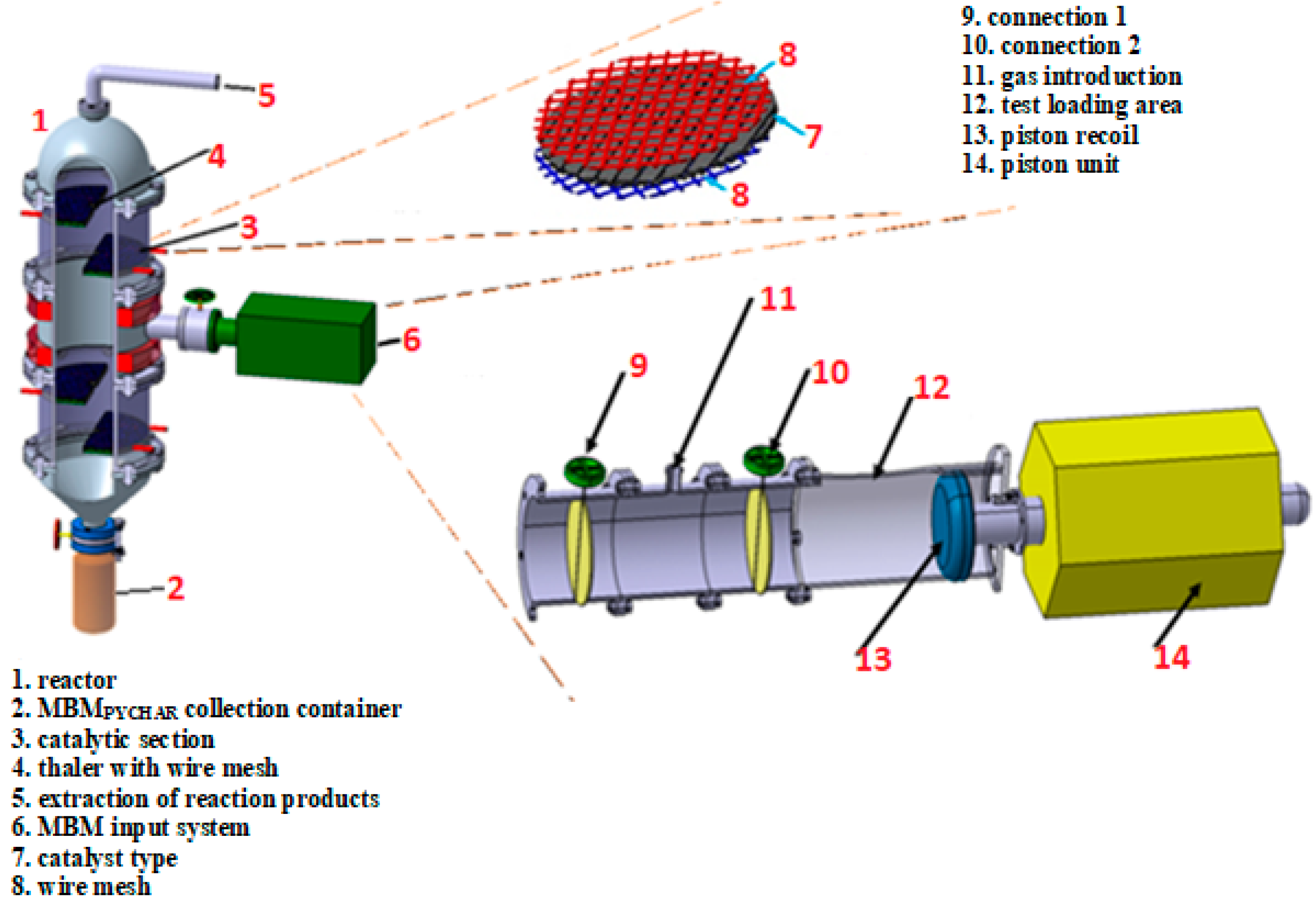

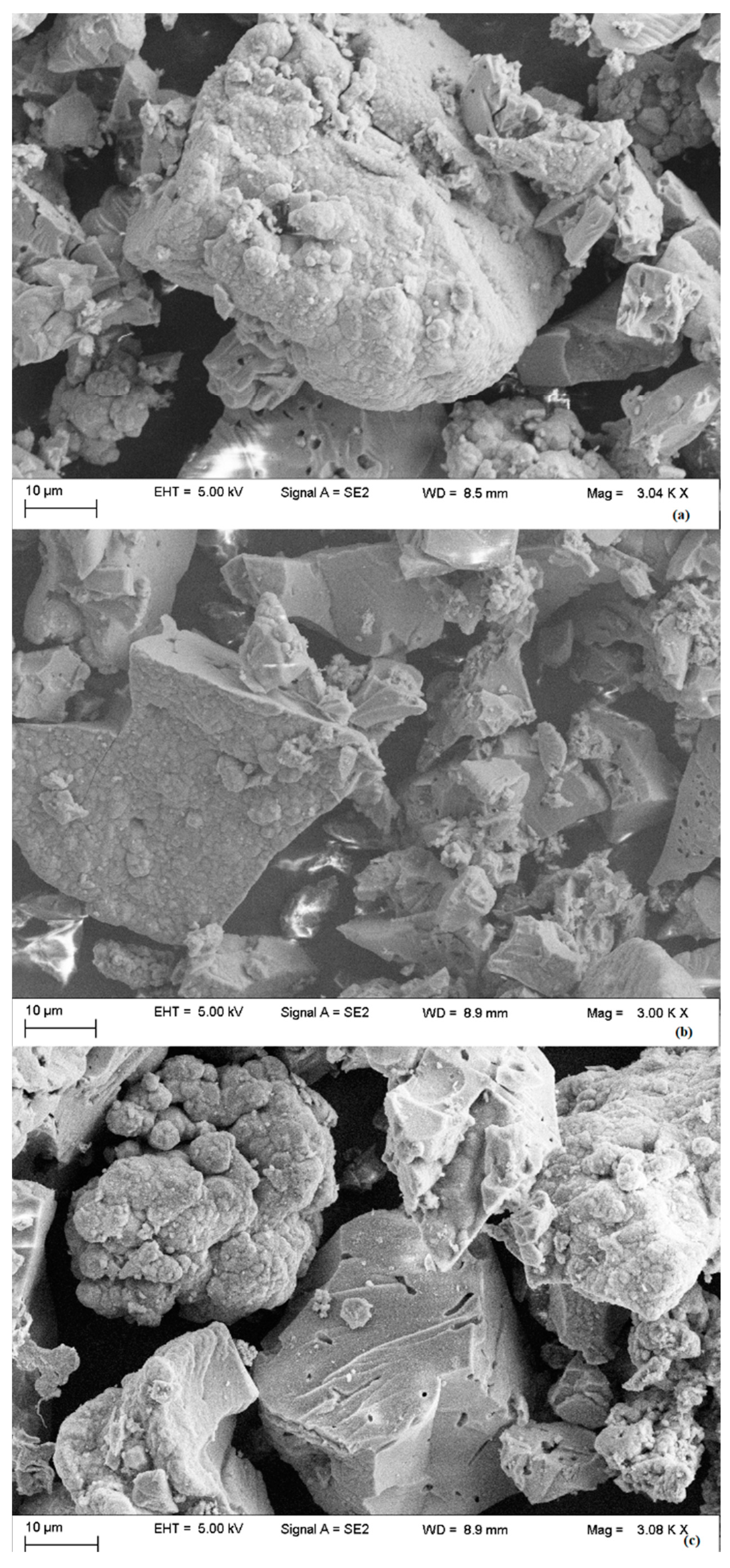
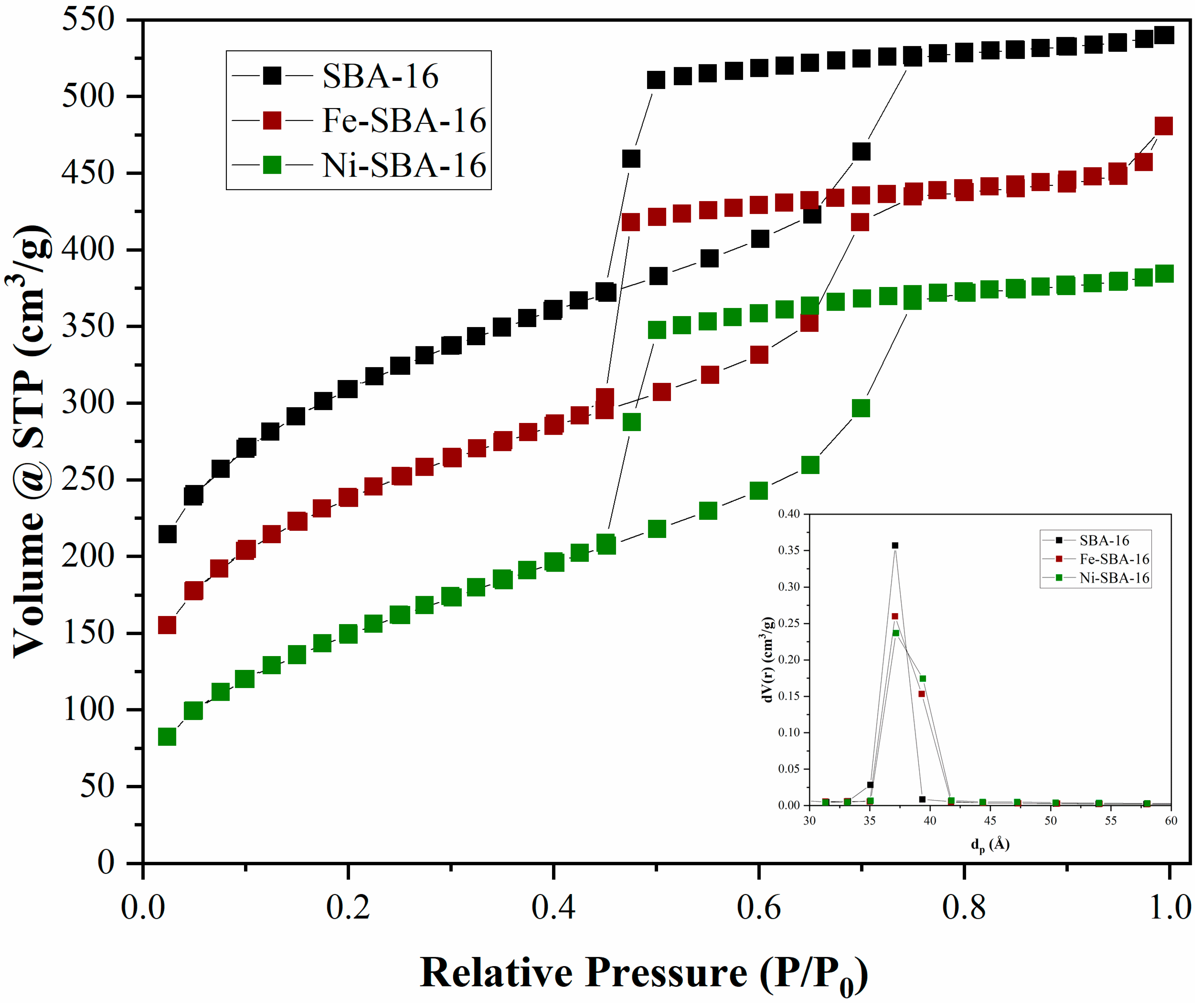
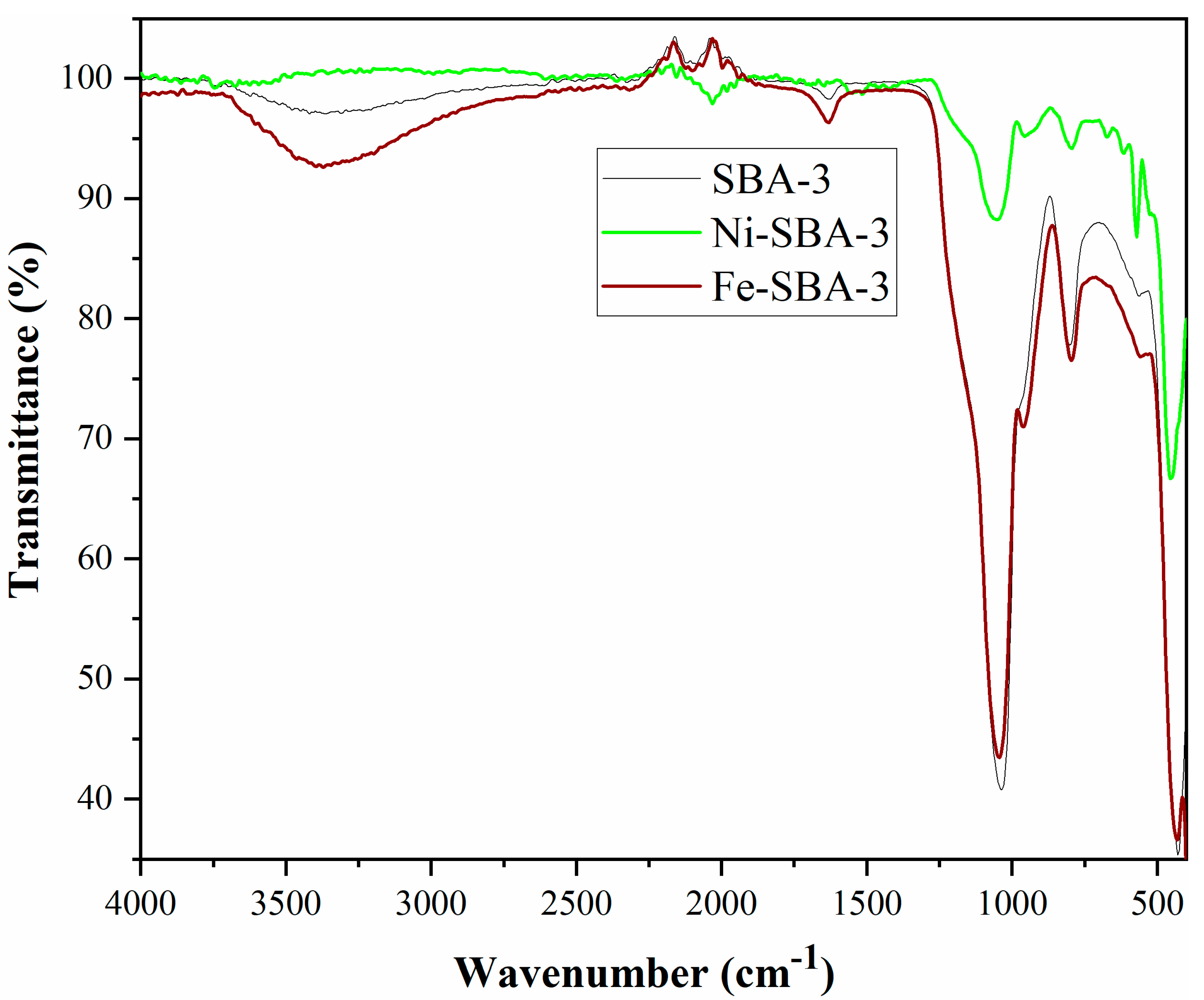

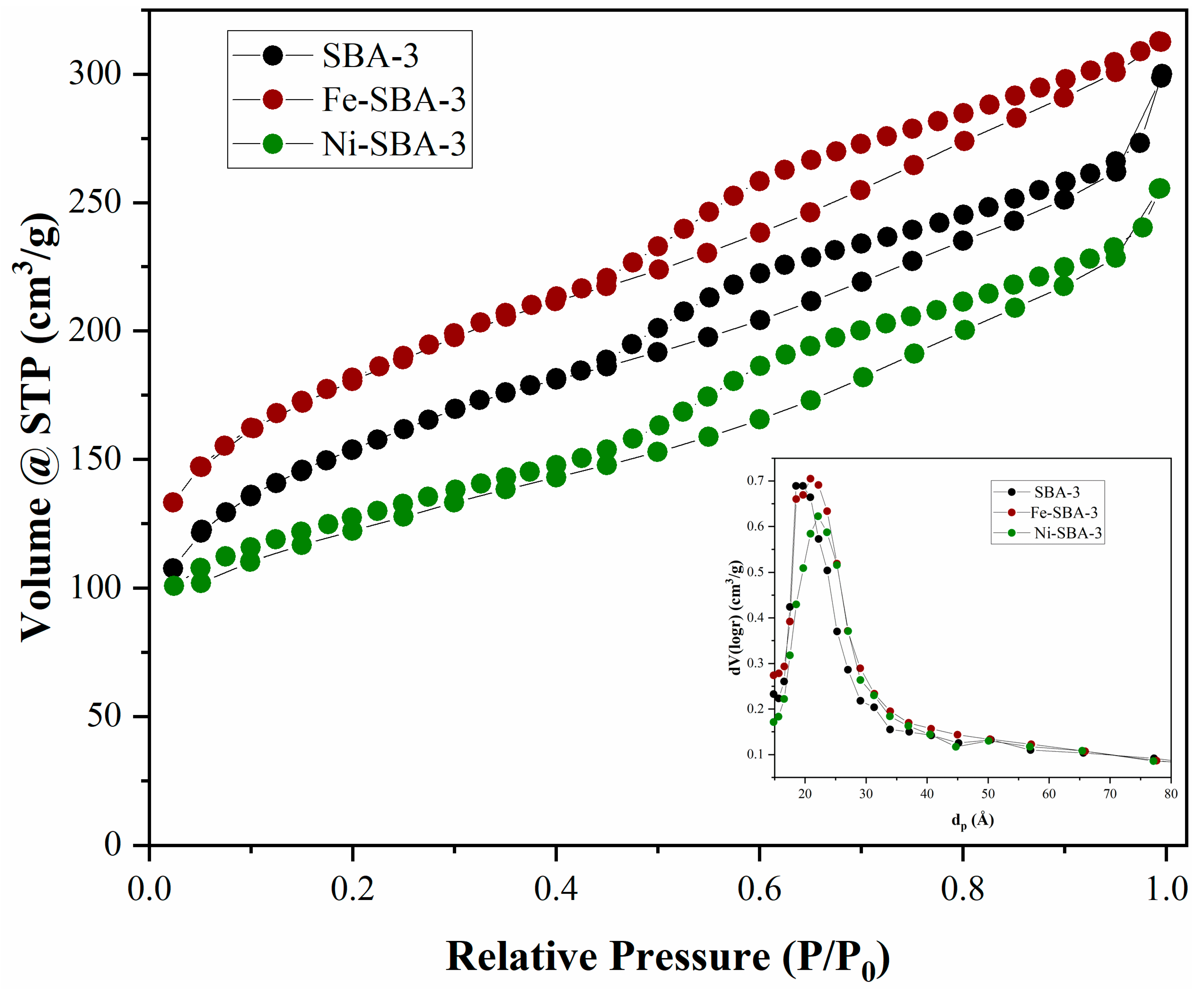
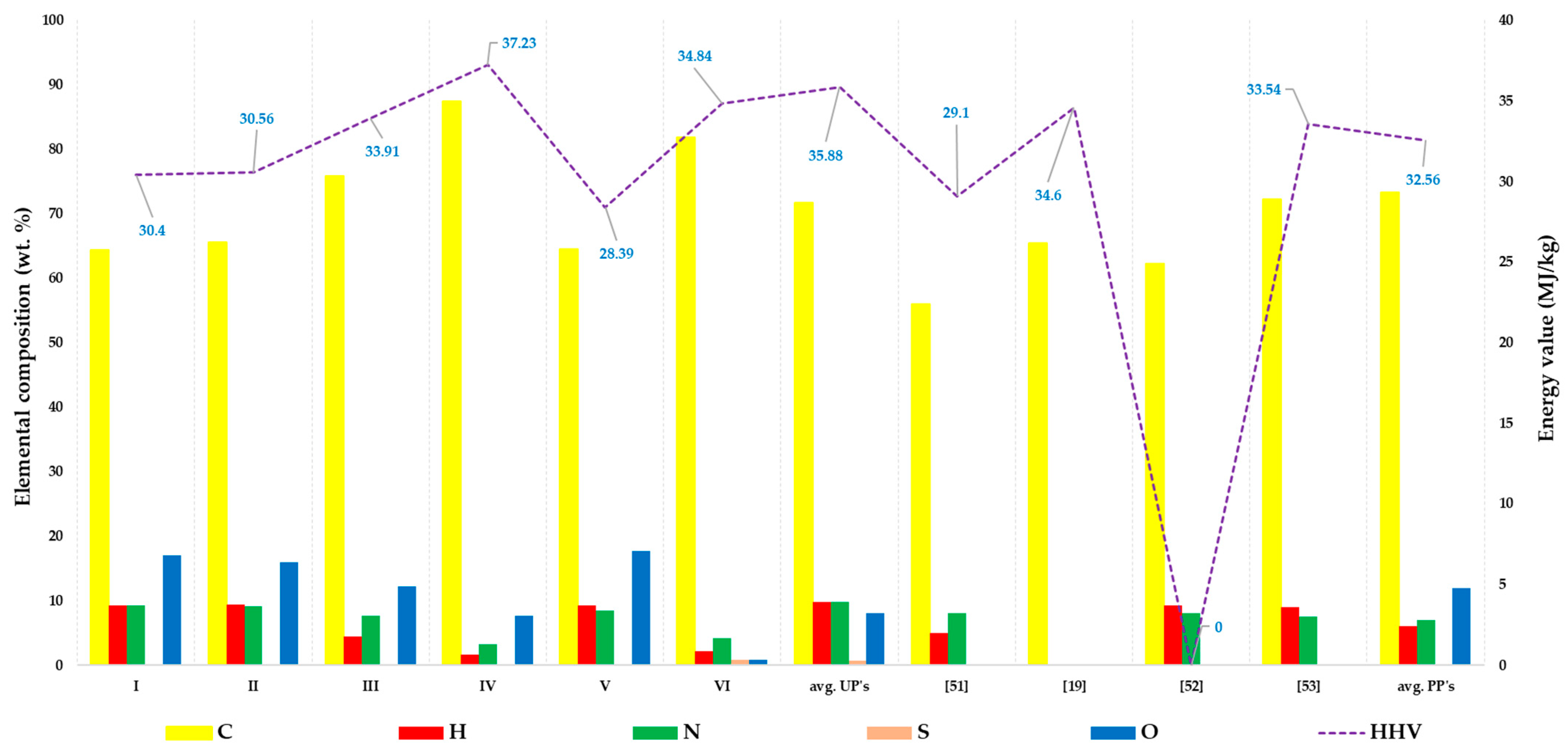
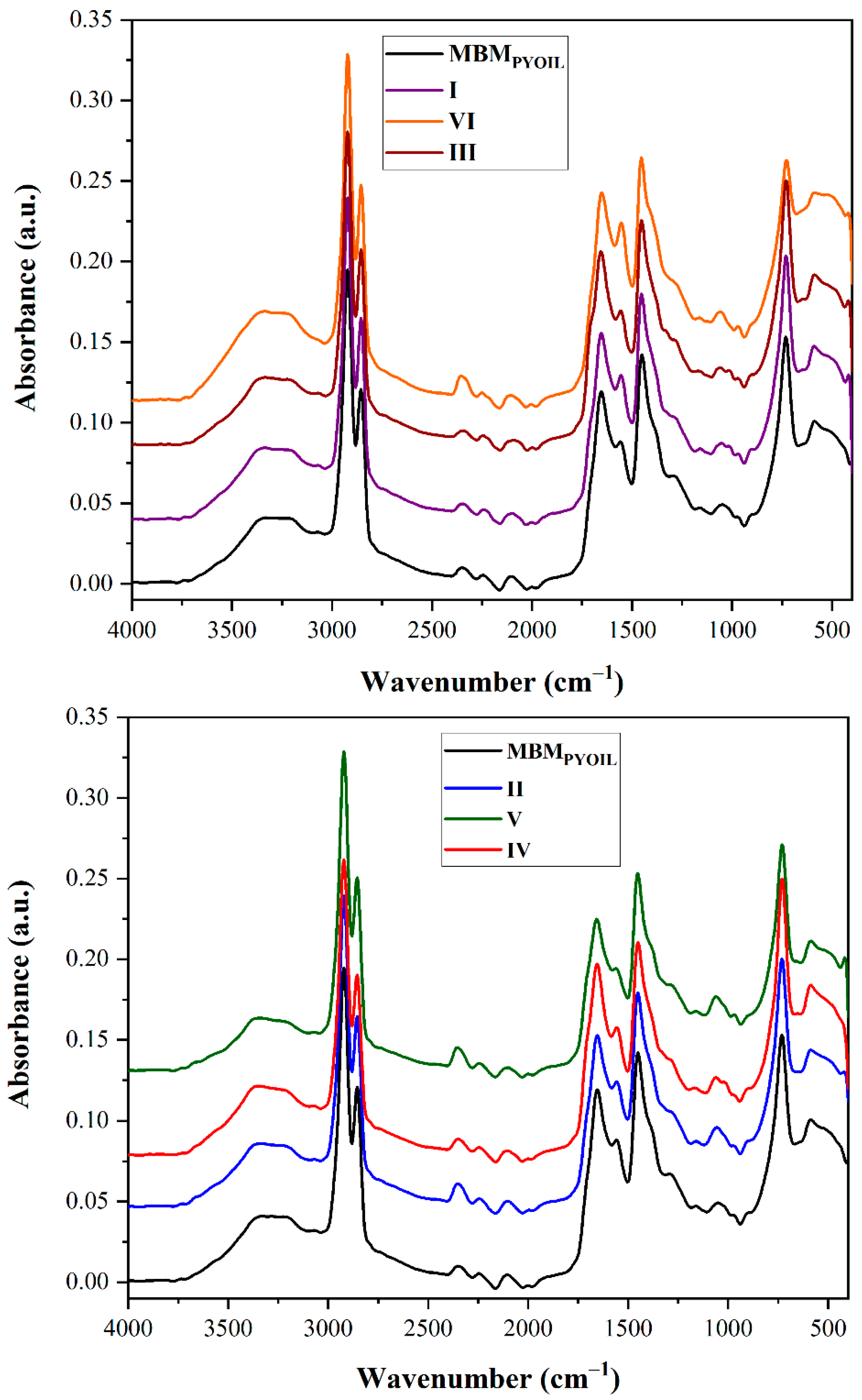
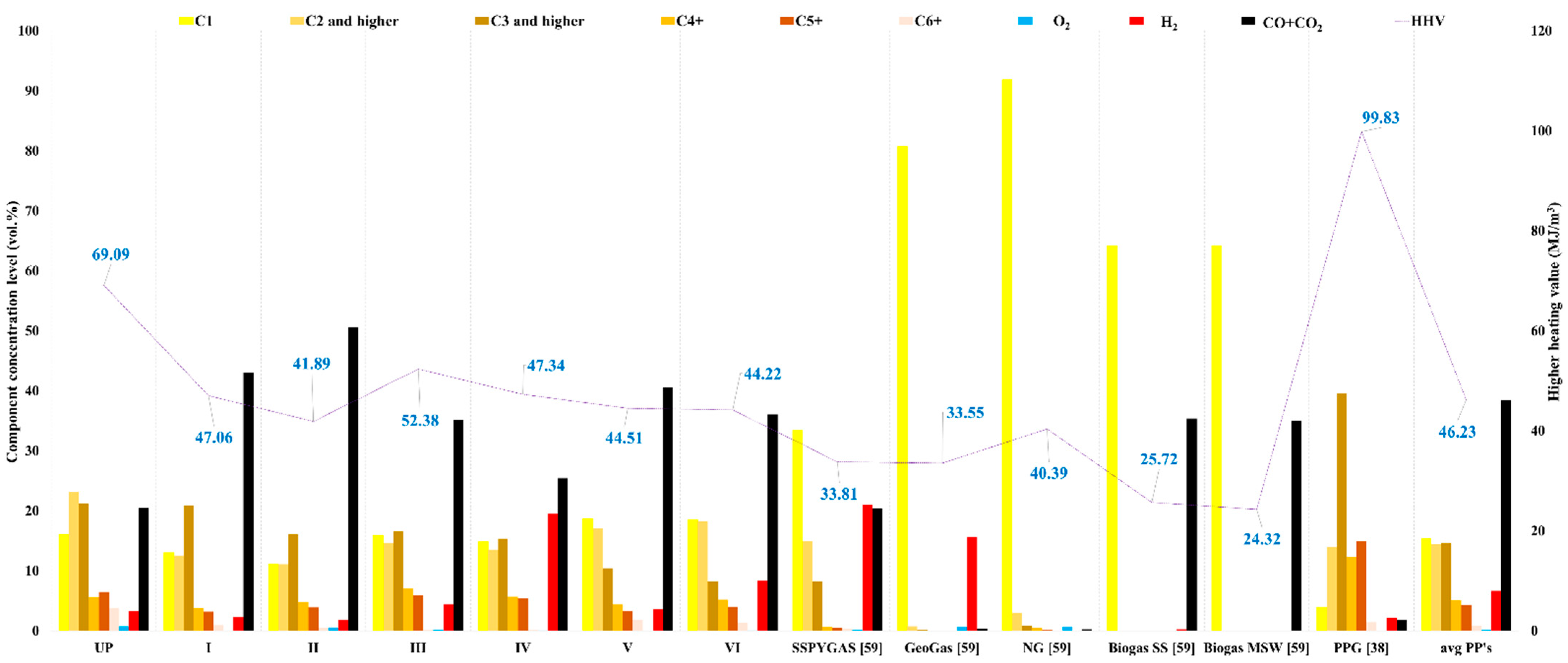
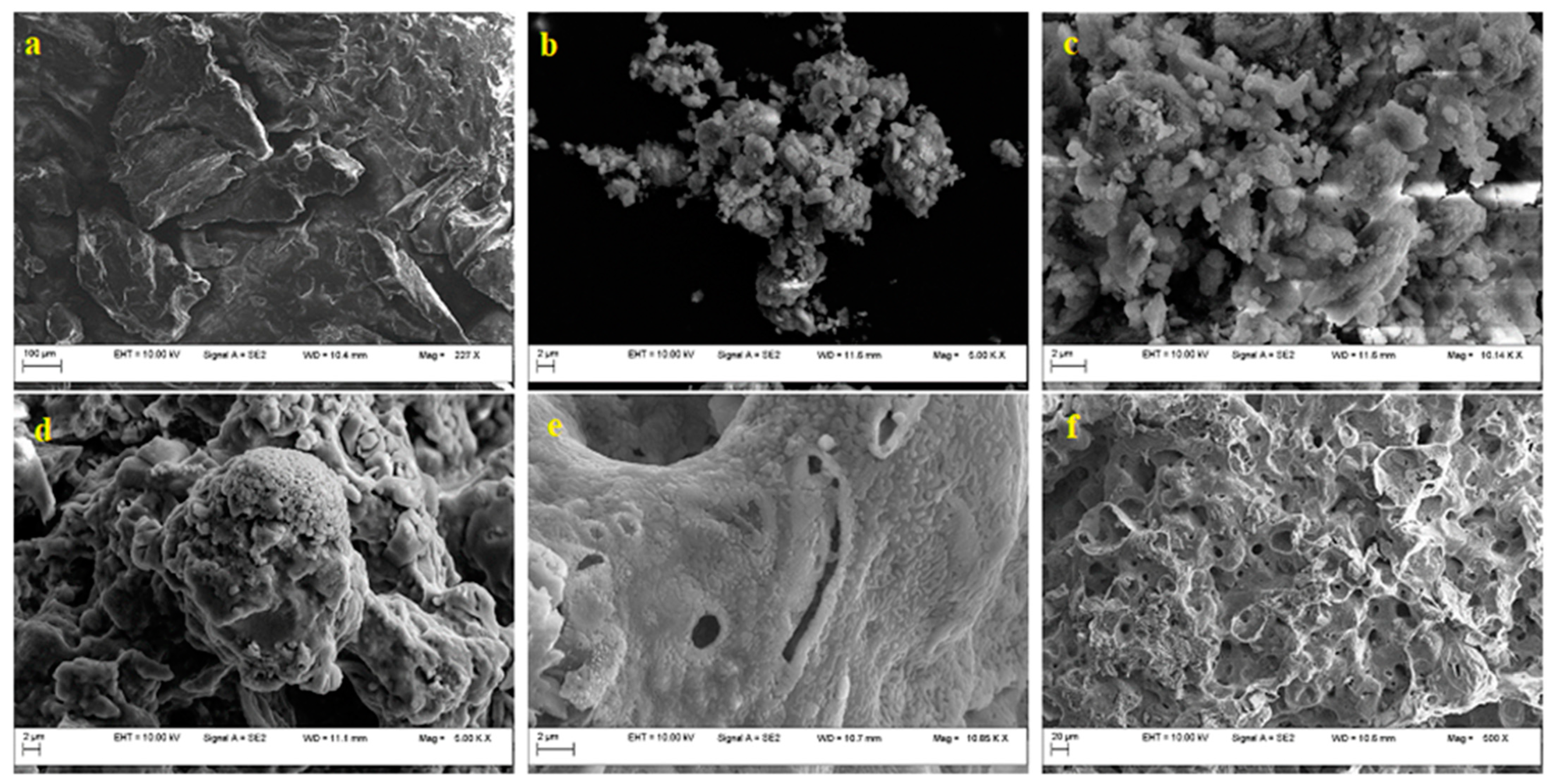
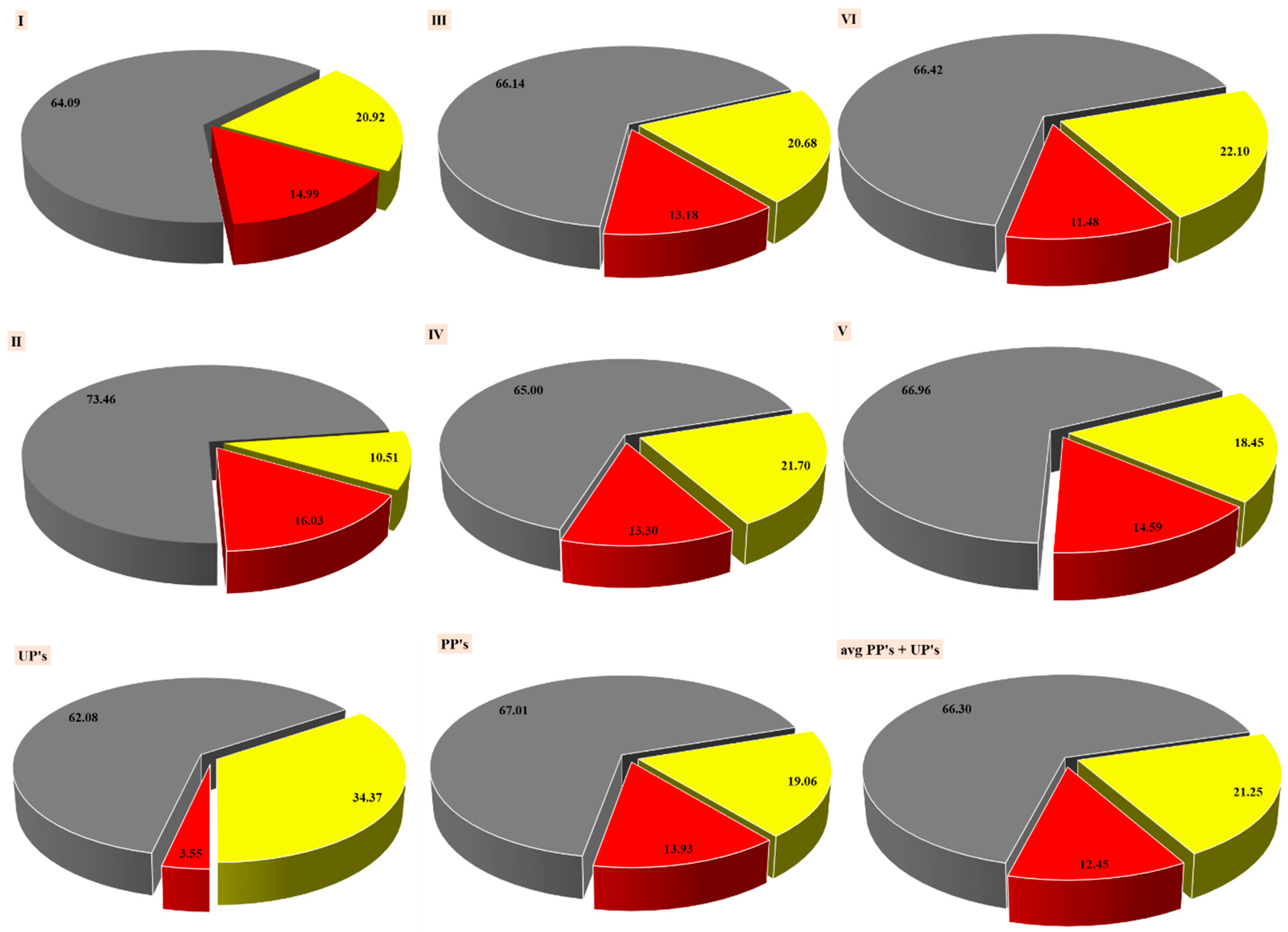
| Sample | C (wt.%) | H (wt.%) | O (wt.%) | Metal (wt.%) | Si (wt.%) |
|---|---|---|---|---|---|
| SBA-16 | 0.29 | 0.41 | 46.26 | - | 53.04 |
| Ni-SBA-16 | 0.76 | 1.42 | 54.39 | 1.54 (EDX)/1.57 (SAA) | 41.86 |
| Fe-SBA-16 | 0.13 | 1.21 | 58.09 | 1.03 (EDX)/0.95 (SAA) | 39.62 |
| Sample | C (wt.%) | H (wt.%) | O (wt.%) | Metal (wt.%) | Si (wt.%) |
|---|---|---|---|---|---|
| SBA-3 | 0.40 | 0.64 | 50.25 | - | 48.71 |
| Ni-SBA-3 | 1.65 | 1.42 | 54.16 | 2.50 (EDX)/2.55 (SAA) | 40.22 |
| Fe-SBA-3 | 0.55 | 1.01 | 51.59 | 0.98 (EDX)/1.00 (SAA) | 45.75 |
| Metals | Fuel Type | |||||||
|---|---|---|---|---|---|---|---|---|
| MBMPYOIL * | PPOPP [57] | PPOHDPE [57] | PPOLDPE [57] | PPOPS [57] | Diesel [54] | Kerosene [54] | Gasoline [55] | |
| Cd | 0.01 | 0.12 | 0.34 | 0.05 | 0.07 | 15.00 | 13.30 | 16.80 |
| Pb | 1.55 | 0.09 | 0.53 | 0.06 | 0.07 | 10.10 | 4.10 | 2.40 |
| Cr | 0.81 | 1.97 | 2.49 | 3.11 | 10.03 | 8.60 | 3.30 | 5.40 |
| Mn | 0.07 | 0.29 | 8.11 | 0.01 | 0.37 | <0.01 | <0.01 | <0.01 |
| Co | 0.02 | 0.21 | 1.39 | 0.07 | 0.16 | <0.01 | <0.01 | <0.01 |
| Ni | 1.29 | 0.56 | 3.83 | 4.56 | 0.02 | <0.01 | <0.01 | <0.01 |
| Cu | <0.01 | 0.06 | 2.31 | 1.75 | 0.27 | 17.70 | 19.80 | 17.40 |
| As | 0.28 | 0.07 | 0.17 | 0.35 | 0.30 | <0.01 | <0.01 | <0.01 |
| Se | <0.01 | 1.61 | 1.72 | 2.40 | 2.12 | <0.01 | <0.01 | <0.01 |
| Hg | <0.01 | <0.01 | <0.01 | <0.01 | 0.01 | <0.01 | <0.01 | 0.77 |
| Rb | <0.01 | 0.17 | 0.01 | 0.21 | 0.22 | <0.01 | <0.01 | <0.01 |
| Sr | <0.01 | 0.06 | 0.72 | 0.05 | 0.15 | <0.01 | <0.01 | <0.01 |
| Parameters | UP | I | II | III | IV | V | VI | |
|---|---|---|---|---|---|---|---|---|
| MBMPYGAS | ||||||||
| HHV (MJ/m3) | 69.09 | 47.06 | 41.89 | 52.38 | 47.34 | 44.51 | 44.22 | |
| LHV (MJ/m3) | 63.38 | 43.15 | 38.42 | 48.02 | 43.40 | 40.75 | 40.49 | |
| Density (kg/m3) | 1.79 | 1.76 | 1.80 | 1.75 | 1.65 | 1.67 | 1.66 | |
| Wobbe number (MJ/m3) | 58.72 | 40.34 | 35.46 | 45.06 | 41.96 | 39.15 | 39.03 | |
| MBMPYCHAR | |||||
|---|---|---|---|---|---|
| Investigation | MBM | MBMPYCHAR (UP’s) | MBMPYCHAR (Oxidized) | MBMPYCHAR (Oxidized; KOH; HCl) | MBMPYCHAR (Oxidized; KOH; HCl; Calcinated) |
| Elemental analysis by GC/TCD (wt.%) | |||||
| C | 20.31 | 10.35 | 6.85 | 20.85 | 24.88 |
| N | 4.14 | 1.74 | 1.32 | 3.46 | 3.51 |
| H | 3.28 | 0.79 | 0.67 | 3.49 | 1.87 |
| S | 0.52 | 0.76 | 0.81 | <0.005 | <0.005 |
| Gravimetric analysis (wt.%) | |||||
| A | 56.14 | - | - | - | - |
| V | 39.52 | - | - | - | - |
| Energy assessment by calorimetry (MJ/kg) | |||||
| HHV | 14.93 | 7.24 | 4.81 | - | - |
| Metal content by atomic absorption/AAS (mg/kg−1) | |||||
| Pb | <17.00 | <17.00 | <17.00 | <17.00 | <17.00 |
| Cu | 15.33 | 31.32 | 16.52 | 70.66 | 96.32 |
| P | 161,801 | 172,830 | 37,612 | 1462 | 7837 |
| Fe | 74.08 | 163.99 | 101.01 | 398.25 | 479.94 |
| Ni | <12.00 | <12.00 | <12.00 | <12.00 | <12.00 |
| Mn | 6.89 | 8.04 | 8.00 | 7.31 | 7.84 |
| Zn | 431.01 | 543.73 | 536.65 | 407.31 | 5.00 |
| Ca | 369,595 | 484,405 | 582,907 | 590 | 3186 |
| Mg | 3114 | 4900 | 4104 | 186 | 111 |
| Na | 8675 | 12,757 | 11,956 | 6813 | 4208 |
| Investigation | Material | ||||
|---|---|---|---|---|---|
| MBM | MBMPYCHAR (UP’s) | MBMPYCHAR (Oxidized) | MBMPYCHAR (Oxidized; KOH; HCl) | MBMPYCHAR-Based Selective Adsorbent | |
| SBET (m2/g) | 1.021 | 117.113 | 0.748 | 2.441 | 125.647 |
| V (cm3/g) | 0.002 | 0.247 | 0.005 | 0.021 | 0.281 |
| Dv(r) (Å) | 15.645 | 18.560 | 18.512 | 15.647 | 18.542 |
Publisher’s Note: MDPI stays neutral with regard to jurisdictional claims in published maps and institutional affiliations. |
© 2022 by the authors. Licensee MDPI, Basel, Switzerland. This article is an open access article distributed under the terms and conditions of the Creative Commons Attribution (CC BY) license (https://creativecommons.org/licenses/by/4.0/).
Share and Cite
Zaharioiu, A.M.; Şandru, C.; Ionete, E.I.; Marin, F.; Ionete, R.E.; Soare, A.; Constantinescu, M.; Bucura, F.; Niculescu, V.-C. Eco-Friendly Alternative Disposal through the Pyrolysis Process of Meat and Bone Meal. Materials 2022, 15, 6593. https://doi.org/10.3390/ma15196593
Zaharioiu AM, Şandru C, Ionete EI, Marin F, Ionete RE, Soare A, Constantinescu M, Bucura F, Niculescu V-C. Eco-Friendly Alternative Disposal through the Pyrolysis Process of Meat and Bone Meal. Materials. 2022; 15(19):6593. https://doi.org/10.3390/ma15196593
Chicago/Turabian StyleZaharioiu, Anca Maria, Claudia Şandru, Eusebiu Ilarian Ionete, Florian Marin, Roxana Elena Ionete, Amalia Soare, Marius Constantinescu, Felicia Bucura, and Violeta-Carolina Niculescu. 2022. "Eco-Friendly Alternative Disposal through the Pyrolysis Process of Meat and Bone Meal" Materials 15, no. 19: 6593. https://doi.org/10.3390/ma15196593
APA StyleZaharioiu, A. M., Şandru, C., Ionete, E. I., Marin, F., Ionete, R. E., Soare, A., Constantinescu, M., Bucura, F., & Niculescu, V.-C. (2022). Eco-Friendly Alternative Disposal through the Pyrolysis Process of Meat and Bone Meal. Materials, 15(19), 6593. https://doi.org/10.3390/ma15196593






